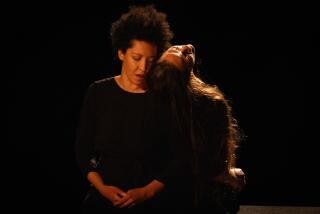Messiaen’s mystical, complex music is reverberating again
When Olivier Messiaen died in 1992 at age 83, there was no doubt that he was a major figure of 20th century music, a great French composer and an important link between Ravel and Pierre Boulez. But great and important are one thing, popular is another.
Ten years ago, Messiaen had only one work that could be said to have entered even the fringe standard repertory -- “Quartet for the End of Time,” which he had written in a Nazi prisoner-of-war camp in 1941. A couple of other pieces -- the “Turangalila” Symphony and the piano cycle, “Vingt Regards sur l’Enfant Jesus” (Twenty Gazes Upon the Infant Jesus) -- were on the fringe of the fringe, accessible and impressive, though too massive and demanding to ever be anything but special-occasion works.
For all the fanaticism Messiaen inspired in his devotees, for all the stellar performers who care deeply for his music, he had such a perplexing collection of unfashionable proclivities that he seemed, at the time of his death, ever destined to be a glorious outsider. Messiaen’s is a music absorbed in mystical Catholicism and invaded by incessant bird song, doused in garish instrumental colors, sweetened with sometimes lurid harmonies, all of it tangled up in obscure, complex Indian rhythmics. Listening to the reed warbler carry on for half an hour in one of the 13 parts of the piano cycle, “Catalog of the Birds,” is enough to drive some audiences -- and pianists -- to distraction.
And yet on the 10th anniversary of Messiaen’s death, he really has arrived. The San Francisco Opera’s gripping American premiere of the composer’s only opera, “Saint Francois d’Assise” -- generally dismissed at its 1983 premiere in Paris as a meditative, unoperatic five-hour self-indulgence -- proved the American operatic event of the year. The San Francisco company also organized a Bay Area-wide Messiaen festival that proved so successful it turned away audiences for a concert at the San Francisco Museum of Modern Art and filled a large hall for a Messiaen symposium at UC Berkeley.
Despite a climate of severe cutbacks at the major record labels, Deutsche Grammophon refuses to kick its Messiaen habit. It has just released a six-CD set of the composer’s complete organ music in very fine performances by Oliver Latry, stunningly recorded at Notre Dame. And this comes on the heels of Myung-Whun Chung’s spectacular account on two CDs of “The Transfiguration of Our Lord Jesus Christ,” with the Orchestra and Chorus of Radio France. Next month DG will release yet another Chung-led two-CD set from Radio France, this time of “From the Canyons to the Stars,” the result of the composer’s spiritually intense, bird-happy visit to Bryce Canyon in Utah.
For Messiaen, music was a grand event intended to express his Faith (something he always capitalized) and his reverence for Nature (also capped). And part of the attraction to this work is its sheer scale -- sonic and temporal. But under even the best of circumstances these big pieces are too labor extensive and expensive to be played or recorded very often.
If Messiaen’s music is to fully enter the mainstream, it needs musical advocates at the grass-roots level. And that has begun to happen. In Los Angeles alone last week there happened to be two performances of “Quartet for the End of Time,” one by New York New Music, an ensemble that played in the Monday Evening Concerts series at the Los Angeles County Museum of Art. The other was by local musicians, as part of a modest weekend Messiaen Festival at First Presbyterian Church in Santa Monica.
That festival could be viewed as a microcosm of how and why Messiaen has taken hold. It was organized not by a music professional but by an enthusiast, Patrick Scott, an administrator with LA’s BEST After School Enrichment Program. The small church is highly resonant, which was great for the massed sonorities in an early organ piece strongly played by Mark Hilt, the festival’s music director and the church’s organist.
In the “Quartet for the End of Time” -- with violinist Robin Lorentz, clarinetist Marty Walker, cellist Roger Lebow and pianist Vicky Ray -- there was a lot of lingering echo. Yet these players, members of the California EAR Unit and Xtet, are specialists in new music, and they brought an intriguing West Coast sensibility to Messiaen’s hallucinatory apocalyptic visions. The third movement, “Abyss of the Birds,” is a plangent clarinet solo, and Walker used the church’s reverberations to make his tone sound disembodied, timeless.
Then for two hours on Sunday afternoon, Mark Robson played the “Vingt Regards.” It was an exceptional, world-class performance, deeply committed and massively virtuosic. This work, written in 1944, shortly after Messiaen was released from the Nazi prison camp, is on one level the ultimate Christmas piece, an adoring vision of the infant Jesus. But as in all of Messiaen, it is full of other, often contradictory things. It has huge philosophical concerns, Hindu rhythms, Greek modes and meters, and some of the most voluptuous, downright erotic sonorities in all of the piano literature.
Before the performance, Scott told the audience that he hoped some day to see Messiaen elevated beyond being merely a musician. “In attempting to find a way to reveal theological concepts through sound,” Scott said, Messiaen “transcends religious denomination and touches on a universal sense of spirituality.”
This is a particularly good time of the year for Messiaen’s music and his message -- no one loved Christmas more than he.
And by the way, if you want an indication of just how widespread Messiaen interest has become, one of the benefactors of the festival was Matt Groening, creator of the “The Simpsons.”
More to Read
The biggest entertainment stories
Get our big stories about Hollywood, film, television, music, arts, culture and more right in your inbox as soon as they publish.
You may occasionally receive promotional content from the Los Angeles Times.











